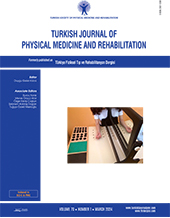Effects of trunk stabilization exercises on balance, functionality and abdominal muscle thickness in hemiplegic patients
Patients and methods: Between April 2019 and June 2019, a total of 26 hemiparesis/hemiplegic patients with stroke (15 males, 11 females; mean age: 62.3±7.8 years; range, 52 to 71 years) confirmed by neurological examination or computed tomography (CT) / magnetic resonance imaging (MRI) and 20 age-matched healthy volunteers (12 males, 8 females; mean age: 62.3±7.2 years; range, 53 to 70 years) were included in the study. The patients were randomized into two groups. In the first group (n=13), TSE were performed in addition to conventional neurorehabilitation program, five times/week for a total of four weeks. The second group (n=13) was given conventional neurorehabilitation program, five times/week for a total of four weeks. Also, healthy volunteers as the third group were compared with the patient population. The evaluations were made at the beginning and end of the treatment. The Berg Balance Scale (BBS), Barthel Index (BI), Postural Assessment Scale for Stroke Patients (PASS), and Functional Reach Test (FRT) were used. Abdominal muscle thickness at rest and contraction were evaluated using USG.
Results: Ten patients in Group 1 and 10 patients in Group 2 completed study. A significant improvement was observed in all abdominal muscles in both groups (p<0.05), indicating no significant difference between the groups (p>0.05). There was a statistically significant improvement for BBS and FRT in both groups. The PASS and BI scores showed a significant improvement only in TSE group.
Conclusion: Both the TSE and conventional neurorehabilitation program provided significant improvements in abdominal muscle thickness, balance and trunk control. For postural control and functionality, additional TSE seems to be more effective.
Keywords : Abdominal muscle, hemiplegia, trunk stabilization, ultrasonography
















